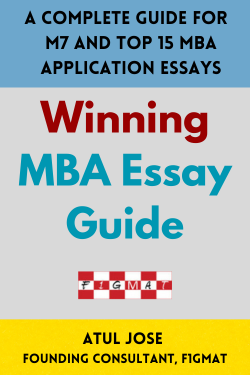Welcome to F1GMAT’s Winning MBA Essay Tips. I am Atul Jose. Today I will guide you on how to answer the Harvard MBA open-ended Essay Question.
So what is the Harvard MBA Essay for the 2023 Entering Class?
The question is
As we review your application, what more would you like us to know as we consider your candidacy for the Harvard Business School MBA program?
Unlike Stanford MBA Essays that have a standard ‘Why Stanford MBA’ question and optional essays that go into your professional and extracurricular contributions, Harvard has stuck with the open-ended question.
If you check out the application form, you will see there are options to highlight your extra-curricular in the Awards & Recognition section.
Additionally, there is a 500 character or 250 words to mention post-MBA goals, which you can use more or less like the ‘Why Stanford’ MBA essay.
There is also a Supplemental Information section to rationalize any weaknesses in your application, like the gap in employment or education. But the admissions team has clearly mentioned not to use the supplemental info section as another essay. So change the tone of the explanation and keep it brief.
For those who are first-generation college students, the Family section has an optional 250-word space that should be strategically used to highlight the challenges your family or you overcame to achieve this unique milestone.
The good thing about the open-ended question is that if you have a unique story, your chance of standing out is higher for Harvard than other schools with traditional goals or leadership essays.
Here are 3 things to consider when you write your Harvard MBA Essay
1. Work on your Resume
This is no surprise for anyone who has started working on your application. All schools will start with your resume. It is extremely important that you customize your job resume to a 1-page format if you have 3-5 years of experience or a 2-page format if you had more than 4 jobs or you have crossed 30 years of age.
Use Action Verbs to start each entry, include your contributions in terms of actions you have taken, skills you have applied, and use numbers to demonstrate scale.
If you don’t have million-dollar transactions or deals or projects, one way to help the admissions team understand the scale of your achievement is to write a one-line bio about your employer with the size of the company or market share in dollars. Then, when you write, let us say about a $200,000 dollar deal or project, the team will understand that the amount was significant for the organization. Don’t assume that the admissions team would do the research about the organization. This advice especially applies to those who are working in startups.
You have to consider the 1-page resume as a snapshot of your life – professionally and personally. So any narrative that you highlight in the essay should connect with the characteristics that could be inferred from your resume.
Let us say you are passionate about climate change, and a lot of your extracurricular time is dedicated to understanding and solving problems in this space. A narrative in the essay about the time you started working with the World Wildlife Fund as a 7-year old or educating local communities through performance arts is all a great way to show your passion in the space and to highlight that the narrative was not just created for the essay. You truly have the work to show.
Although the question is clearly about additional information not captured in the application, including resume, some scent of the narrative should be captured in the resume. If you need help, you can subscribe to my resume editing service by visiting store.f1gmat.com/mba-resume-editing
2. Understand Stereotypes
There are three types of stereotypes – positive, negative, and overused.
A positive Stereotype that you might have heard is that Asians, including Indians, tend to be extremely hard-working. They mind their own business. Don’t make a hue and cry about any issues affecting the community. But what seems positive in a popular narrative is a negative stereotype in admissions. If you just work hard, have great grades but are not involved in the community, it is a negative for class engagement and for the experiential learning that is a big part of the Harvard MBA experience, including the case study method. If you fall into that stereotype, it is important that you include volunteering into the Harvard MBA Essay narrative.
Negative Stereotypes are mostly related to the kind of job you are doing. If you are an Investment Banker, it is unlikely that you would be a soft-spoken person or keep opinions to yourself. This is a good stereotype for admissions as you would be engaged and wouldn’t need any nudging to get things done, prepare and express your opinions. But the admissions team might also find you overbearing and taking over precious time from the team, and dominating the conversation. This might not be true in how you engage, but a strategy that has worked for IB professionals is to balance the high-achiever narrative with some volunteering that requires sensitively handling a crisis or working with the underprivileged in the community.
Similarly, if you are from Technology, the negative stereotype is that you are unlikely to have great social skills since you are mostly working with systems and algorithms over spending time with people. Obviously, as you progress in your career – regardless of the industry, the more time you would be spending with people over a functional role, that is typically what you might be doing now with less than 5 years of experience. In that case, you have to highlight an extracurricular that demonstrated interpersonal skills either in the form of leading a team through a promotional campaign that required informing and educating the community about a cause or working with multiple stakeholders in a pro bono consulting role.
The ‘overused’ stereotype is the most challenging one to avoid. I had the fortune to work with a lot of Chinese clients. I noticed that regardless of whether they came from mainland China or were brought up in the US, Piano or Violin skills were an integral part of the extracurricular. There is nothing wrong in highlighting this extracurricular but let us assume that this data has become the hook that triggers typecasting the applicant into the ‘Asian’ – minding their own business, low community engagement negative stereotype. We have to assume that it does. Then, you really have to find other examples that don’t allow the admissions team to quickly make that assumption. Preferably include team sports or any extracurricular that require team collaboration over solo performance.
I know that great progress has been made over the past few years across business schools and universities to recognize and address systemic inequalities. But we are still at an early stage of rewiring our brain against a lot of biases, and the admissions team is also a microcosm of our society and our flawed thinking. So don’t allow them to quickly reach a wrong conclusion.
3. Personal or Professional Narrative
The third challenge while shortlisting stories for your Harvard MBA Essays is deciding between Professional or personal examples.
If you have a unique professional experience like working on a presidential campaign or part of a deal that was covered extensively in the popular media in the past 1-2 years or combat experience in the military, then make the narrative about your professional engagement.
All of us go through some trauma – real or imagined as a child. It becomes a motivating force to follow a career or passion. This narrative is the most commonly used one. For all those who have a traditional career with good enough achievements, then use ‘trauma’ as the core of the narrative. A common one I have seen applicants mention is ‘bullying’ either when choosing a non-traditional career or bullying when the person was trying to do a greater good for the family or community.
Another personal narrative that has touched a chord with me while reading is about hardships. This is tricky to capture.
Hardships for a billionaire might be losing out on the Forbes richest person list or losing the privilege to use their jet. Understand and shortlist only those examples of hardships that are truly recognizable in any part of the world.
I have heard stories of starvation, reusing clothes for a week, and stories of working 2 jobs while completing their undergraduate degree. These are unusual for the application pool and truly unique. And such narratives will stand out for authenticity. But you don’t have to manufacture any such narrative if you don’t have any.
Go for the Professional, Trauma, or Unique Childhood experiences.
A better strategy is to include both personal and professional narratives. This could be done with ‘values’ as the core theme.
If ‘taking initiatives’ or ‘leadership’ is a core value, it is unlikely that you could show the skills only professionally and not in your personal or extracurricular engagements. Then, the narrative could be about why you lead. It could be tied to a childhood event and then mix it up with your school, undergraduate degree, and professional experiences.
Again, the tricky part of this narrative is the transitions. If you want to invest in a consultant, check out how they transition in their essays. I have tried some unique transitions in F1GMAT’s Harvard MBA Essay Guide, where I have included 14 Narrative Examples and 300+ pages on Essay Writing and Editing.
If you need my help in guiding you through the Essay Writing process and reviewing the Harvard MBA Essay, subscribe to F1GMAT’s Essay Review Service by visiting store.f1gmat.com/essay-review
 I will teach you how to bring your life stories to essays faster with F1GMAT's essay guides. Download below or subscribe to F1GMAT's Service and work with me - Atul Jose, Author/Editor/Founding Consultant, F1GMAT(16 Years of helping applicants gain admissions to M7 and Top 30 schools)
I will teach you how to bring your life stories to essays faster with F1GMAT's essay guides. Download below or subscribe to F1GMAT's Service and work with me - Atul Jose, Author/Editor/Founding Consultant, F1GMAT(16 Years of helping applicants gain admissions to M7 and Top 30 schools) 